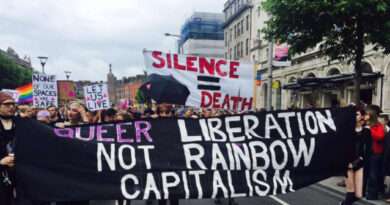Understanding asexual perspectives on body image and self-perception
By Sohini Sengupta
In a world where looks and being sexually desired usually shape how we see ourselves, the people who put the A in LGBTQIA+, have a different experience. They predominantly don’t feel sexual attraction to others, or experience it to marginal and/or externally-dependent degrees, which can make them question society’s ideas about body image and self-worth. Instead of focusing on physical appearance, they often challenge the usual beliefs, which can lead to a complicated connection with their bodies.
Many asexual folks find that their relationship with sexual attraction changes how they see themselves. They focus more on valuing themselves for who they are rather than how they look. They appreciate their bodies for what they can do, rather than what society says they should look like. But even with this different perspective, asexual people still feel pressure to fit in with societal beauty standards. Media and cultural norms can make them feel insecure about their bodies, making it hard for them to accept themselves fully.
Additionally, the way asexuality intersects with gender identity can make things even more complicated. Asexual folks who also identify as trans or non-binary might have to deal with extra obstacles when it comes to fitting in with society’s standards, especially when it comes to how they view their own bodies.

The role of sexual attraction in body image
On the flip side, feeling good about our bodies can boost our confidence in the bedroom. Having fulfilling sexual experiences can also make us feel better about our bodies. This shows that intimacy can help us break free from negative self-image and accept ourselves. It’s important to recognize how sexual attraction influences our body image for a healthier self-perception. By challenging unrealistic beauty standards and focusing on the value of intimacy and connection, we can build a better relationship with our bodies, leading to more satisfaction and well-being.
Sexual attraction has a big impact on how we see ourselves and our bodies. Society’s beauty standards often make us feel pressure to look a certain way, which can affect our self-esteem and how we view our own attractiveness. People often link their physical appearance to how desirable they are. Feeling unattractive can make us less interested in sex, which can then lower our self-esteem even more.
Seeing perfect body images in the media can also make us feel bad about ourselves. As noted in a qualitative study, some women expressed that the loss of sexual desire was associated with feelings of low well-being, mood disturbances, and unhappiness. The negative effects of sexual reluctance on mental health and personal distress were confirmed, indicating that sexual dysfunction can significantly affect both emotional and physiological health (Akhavan Akbari et al., 2018)
Even though asexual individuals don’t feel sexual attraction, they still feel pressured to look a certain way due to societal standards. This can lead to feelings of insecurity and body dissatisfaction. Despite this, some have learned to focus on their health and well-being rather than conforming to traditional beauty ideals. To combat these pressures, asexual individuals often practice self-acceptance techniques like mindfulness and body positivity affirmations to embrace their uniqueness and develop a more positive self-image.
Intersection of asexuality, gender identity, and body dysphoria
Recognizing these different terms and the diverse experiences of asexual individuals can help us better understand how asexuality, gender identity, and body image are all connected. This understanding not only validates their experiences but also promotes inclusivity and understanding in conversations about identity and self-acceptance. For example, a non-binary asexual person might feel disconnected from their body because it doesn’t match how they see themselves. One feature often present in non-heteronormative, non-cis-gender identities is discomfort and/or dysphoria. This can come from societal pressures to conform to norms which their identity breaks, or from having a body that does not match how they feel and view themselves (Bianchi, 2018). This creates challenges when it comes to relating to others, sexually or otherwise.
It’s a constant struggle to accept my true self in a world that has its own ideas of beauty. This shows the importance of understanding how asexuality and gender identity can affect body image and self-esteem. Graysexuality is for those who rarely feel sexual attraction or only feel it in certain situations. People who identify as graysexual may feel uncomfortable when they’re not understood or accepted by both asexual and sexual communities.
The Asexual Visibility and Education Network, referred to as AVEN, is an online resource and community building platform for increasing the awareness and visibility of asexuality. Started in 2001 by David Jay, AVEN is a website that would act as a resource and community for people identifying as asexual, offering support, information, and discussion of personal experience and identity.
One such discussion, in December 2013, took place on AVEN. In this thread, some users shared their opinions related to body image and asexuality in terms of self-perception.
An asexual member shared a personal experience of feeling good about their body after weight loss, emphasizing, “I still want to be pretty without attracting sexual attention because that’s not what I want.” (link)
Another person emphasized the complexity of body image issues, noting, “Body image issues have so many more causes than just sex appeal… asexuals may not feel sexual attraction, but how many sexual people are sexually attracted to themselves anyway?” (link)
However, they can also find joy in moments of connection that honor their unique experiences, helping them embrace who they are without feeling pressured to be a certain way. For example, demisexuality describes people who only feel sexual attraction after forming a strong emotional bond. This label can make someone feel uneasy when society expects them to be attracted to others right away. They might feel pressure to fit into traditional ideas of romance, which can make them feel uneasy about their body and who they are. But finding partners who respect their boundaries and appreciate their emotional depth can make them feel happier and more sure of themselves.
When asexuality and gender identity intersect, it can create a complex experience for individuals figuring out who they are, especially when it comes to feeling comfortable or uncomfortable in their own skin. A lack of sexual attraction, which is common in asexuality, often intertwines with different gender identities, leading to unique challenges and experiences. Terms like “demisexual,” “graysexual,” and “aceflux” represent the diverse range of asexual identities and the different feelings of discomfort or happiness that come with them.
Aceflux individuals have fluctuating levels of sexual attraction, which can complicate their relationship with their body and identity. Their experiences can make them feel uneasy when they’re not feeling attracted to others, as societal norms often link being desirable with feeling attracted to others. On the other hand, moments of happiness can come when they accept who they are and find support from those around them.

Strategies for cultivating positive body image
It can be tough for asexual folks to feel good about their bodies due to societal norms linking self-worth to sexual appeal. While body positivity is great, body neutrality is another option that many asexual people find helpful. By appreciating our bodies for what they can do rather than how they look, we can shift our focus away from societal beauty standards. It’s important to challenge negative self-talk, especially when society places so much emphasis on attractiveness. Research indicates that the long-term effects of negative self-talk can lead to significant changes in brain connectivity, which underlie cognitive performance changes (Kim et al., 2021). This underscores the necessity of fostering a more positive internal dialogue to mitigate these adverse effects.
Instead of criticizing our appearance, we can focus on our body’s strengths and the experiences it allows us to have. By embracing body neutrality and acknowledging that our value isn’t tied to sexual attraction or beauty standards, we can foster a healthier relationship with ourselves and celebrate our identity as asexual individuals. One way to cultivate body neutrality is to practice gratitude for our body’s abilities, like walking or dancing. Writing a letter of appreciation for our body’s strengths can help us recognize our worth beyond appearance. Engaging in self-care activities like yoga and meditation can also promote body awareness and self-acceptance, allowing us to enjoy movement without the pressure of sexual validation.
This understanding will hopefully get us talking about body image, self-worth, and empathy in our interactions with others.



